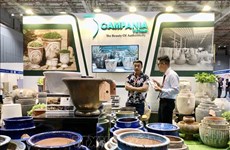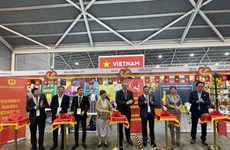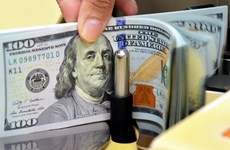Hanoi eyes great fisheries potential
With vast water surface areas and a large market for fish, Hanoi has high potential for sustainable aquaculture development.
With vast water surface areas and a large market for fish, Hanoi has high potential for sustainable aquaculture development.
The Fisheries Department is looking for more organisations to invest in aquaculture infrastructure. More than 30,800ha of surface water across the greater city area could be used for aquaculture, including 6,700ha of ponds and 19,800ha of low-lying fields.
High technology production methods have made fish and seafood farming more productive over the years.
In 2009, 19.519ha of the city were covered by aquaculture. This increased to 20.838ha in 2014. Total aquatic product output reached 90,000 tonnes in 2014 and accounted for 37 percent of capital residents' demand.
To pave the way for developing Hanoi's aquatic products industry in a sustainable manner, the municipal People's Committee approved the Programme on Aquaculture Development for the 2009-2015 period.
The committee hopes to bring Hanoi's total aquaculture areas to 24,000ha by 2020, with a total aquatic product output of 132,000 tonnes. The capital's aquaculture sector has formed several concentrated areas producing aquatic products. These areas located in the districts to the south of Hanoi include Phu Xuyen, Thuong Tin, Ung Hoa, My Duc and Chuong My.
Dong My Commune is a large aquaculture area. It has 111ha of surface water area and provides Hanoi with 700 tonnes of assorted fish and shrimps every year. The commune continues to work to develop a high-quality aquaculture area, coupled with ecotourism and general farms. It also aims to build its brand name, Dong My Aquatic Products.
On average, each hectare of aquaculture in the commune brings in 102 million VND (4,720 USD) in revenue.
Vu Van Tuan, deputy head of Thuong Tin district's Economic Department, said the concentrated aquaculture model made the process more efficient and raised residents' incomes.
Authorities warned farmers about environmental impacts and diseases that could affect their yields.
Good environment and available clean water sources are the ideal conditions for the aquaculture development of Hanoi, according to Tuan.
The city has invested in upgrading aquaculture infrastructure with the aim to supply high-quality, disease-free aquatic varieties, as well as provide technical training and build intensive aquaculture models.
However, some fish species are in danger of extinction. Using poison, explosives and electrical impulses in fishing also contributed to their decline. To solve the problem, Ta Van Son, Deputy Director of the Hanoi Fisheries Department, said the department has taught farmers about protecting fish and increasing fisheries' output.-VNA
The Fisheries Department is looking for more organisations to invest in aquaculture infrastructure. More than 30,800ha of surface water across the greater city area could be used for aquaculture, including 6,700ha of ponds and 19,800ha of low-lying fields.
High technology production methods have made fish and seafood farming more productive over the years.
In 2009, 19.519ha of the city were covered by aquaculture. This increased to 20.838ha in 2014. Total aquatic product output reached 90,000 tonnes in 2014 and accounted for 37 percent of capital residents' demand.
To pave the way for developing Hanoi's aquatic products industry in a sustainable manner, the municipal People's Committee approved the Programme on Aquaculture Development for the 2009-2015 period.
The committee hopes to bring Hanoi's total aquaculture areas to 24,000ha by 2020, with a total aquatic product output of 132,000 tonnes. The capital's aquaculture sector has formed several concentrated areas producing aquatic products. These areas located in the districts to the south of Hanoi include Phu Xuyen, Thuong Tin, Ung Hoa, My Duc and Chuong My.
Dong My Commune is a large aquaculture area. It has 111ha of surface water area and provides Hanoi with 700 tonnes of assorted fish and shrimps every year. The commune continues to work to develop a high-quality aquaculture area, coupled with ecotourism and general farms. It also aims to build its brand name, Dong My Aquatic Products.
On average, each hectare of aquaculture in the commune brings in 102 million VND (4,720 USD) in revenue.
Vu Van Tuan, deputy head of Thuong Tin district's Economic Department, said the concentrated aquaculture model made the process more efficient and raised residents' incomes.
Authorities warned farmers about environmental impacts and diseases that could affect their yields.
Good environment and available clean water sources are the ideal conditions for the aquaculture development of Hanoi, according to Tuan.
The city has invested in upgrading aquaculture infrastructure with the aim to supply high-quality, disease-free aquatic varieties, as well as provide technical training and build intensive aquaculture models.
However, some fish species are in danger of extinction. Using poison, explosives and electrical impulses in fishing also contributed to their decline. To solve the problem, Ta Van Son, Deputy Director of the Hanoi Fisheries Department, said the department has taught farmers about protecting fish and increasing fisheries' output.-VNA













